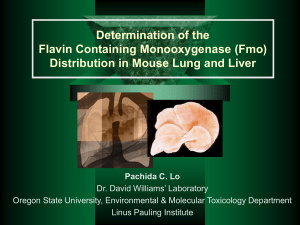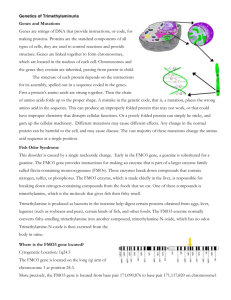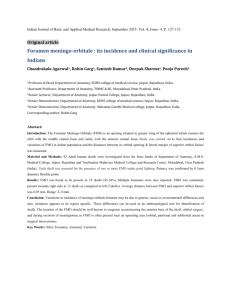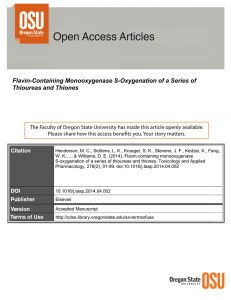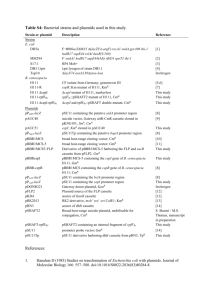determination of the flavin-containing monooxygenase distribution in
advertisement
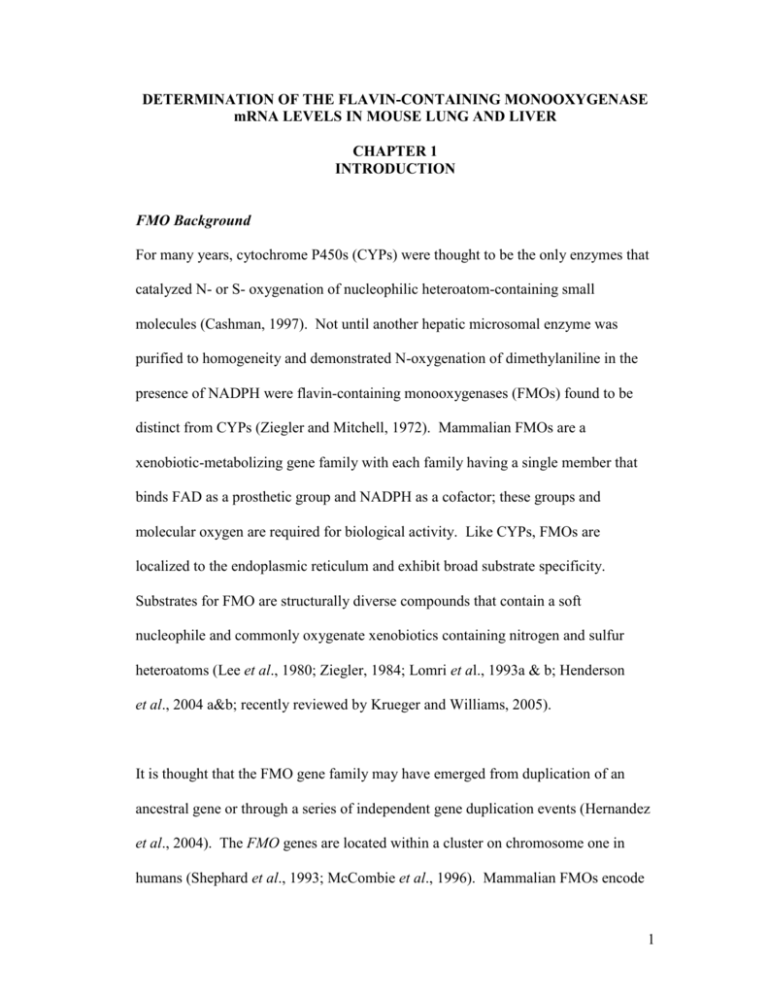
DETERMINATION OF THE FLAVIN-CONTAINING MONOOXYGENASE mRNA LEVELS IN MOUSE LUNG AND LIVER CHAPTER 1 INTRODUCTION FMO Background For many years, cytochrome P450s (CYPs) were thought to be the only enzymes that catalyzed N- or S- oxygenation of nucleophilic heteroatom-containing small molecules (Cashman, 1997). Not until another hepatic microsomal enzyme was purified to homogeneity and demonstrated N-oxygenation of dimethylaniline in the presence of NADPH were flavin-containing monooxygenases (FMOs) found to be distinct from CYPs (Ziegler and Mitchell, 1972). Mammalian FMOs are a xenobiotic-metabolizing gene family with each family having a single member that binds FAD as a prosthetic group and NADPH as a cofactor; these groups and molecular oxygen are required for biological activity. Like CYPs, FMOs are localized to the endoplasmic reticulum and exhibit broad substrate specificity. Substrates for FMO are structurally diverse compounds that contain a soft nucleophile and commonly oxygenate xenobiotics containing nitrogen and sulfur heteroatoms (Lee et al., 1980; Ziegler, 1984; Lomri et al., 1993a & b; Henderson et al., 2004 a&b; recently reviewed by Krueger and Williams, 2005). It is thought that the FMO gene family may have emerged from duplication of an ancestral gene or through a series of independent gene duplication events (Hernandez et al., 2004). The FMO genes are located within a cluster on chromosome one in humans (Shephard et al., 1993; McCombie et al., 1996). Mammalian FMOs encode 1 protein products that are 532-558 amino acids in length and all contain highly conserved FAD- and NADPH-binding sites (Atta-Asafo-Adjei et al., 1993; Lawton and Philpot, 1993). In general, members of the mammalian Fmo gene family share from 52-58% sequence identity (Hines et al., 1993; Lawton et al., 1994). Each, Fmo family indicated by the first member (1, 2, etc.) has only one member. The sequence identities of orthologous FMOs from different species are generally greater than 82% (Lawton et al., 1990). Normally, orthologs retain the same function in the course of evolution rendering the identification of orthologs critical for reliable prediction of gene function in newly sequenced genomes. In humans, eleven FMO families exist that include five pseudogenes; and in mouse nine families have been documented that may all be expressed. Human Ethnic Polymorphisms Among the FMO families, considerable allelic variability in FMO enzyme function can result from small base changes in the wild-type gene (Cashman et al., 2000; Cashman 2004, Krueger and Williams, 2005). In particular, two important polymorphisms exist in human FMO2. All Caucasians and Asians genotyped to date are homologous for a genetic polymorphism, the FMO2*2 allele, in which a CT transition at bp 1414 replaces a glutamine at amino acid residue 472 with a stop codon (Dolphin et al., 1998; Whetsine et al., 2000). This change produces a nonfunctional truncated FMO2.2 protein from the FMO2*2 allele (Dolphin et al., 1998; Krueger et al., 2002). FMO2.2 does not incorporate FAD and is not detected on western blots of human pulmonary microsomes presumably due to degradation and 2 incorrect folding. The FMO2*1 allele, that encodes full-length functional FMO2.1 enzyme, is present in individuals from African (27%) and Hispanic (2 to 7%) populations (Dolphin et al., 1998; Whetsine et al., 2000; Krueger et al., 2002; Furnes et al., 2003; Krueger et al., 2004). Potential for Differential Metabolism Eleven distinct FMO genes exist in humans encoding five functional enzymes (FMO1-5) and six pseudogenes. (Haining et al., 1997; Myers et al., 1997; Overby et al., 1997; Whetstine et al., 2000; Yeung et al., 2000). Of the FMO isoforms, FMO1, FMO2 and FMO3 are the main drug metabolizing enzymes in mammals and all exhibit broad substrate specificities. For example, FMO1 appears to have a less restricted substrate access channel and accepts larger N- and S-containing nucleophiles than human FMO3 (Taylor and Ziegler, 1987; Hvattum et al., 1991; Attar et al., 2003; Lomri et al., 1993b; Overby et al., 1995); however, both show efficient activity for S-oxygenation of sulfur-containing chemicals, such as thioureas and thioamides, similar to FMO2. In general, metabolism by FMO yields metabolic products that are more polar and less toxic or less biologically active and more readily excreted than the parent compound (Ziegler, 1984; Damani, 1988). This function allows the body to remove unwanted natural products from the diet (e.g., amine-, sulfide-, phosphorus-, and other nucleophilic heteroatom-containing compounds). However, in contrast to other heteroatoms, sulfur oxygenation sometimes results in bioactivation (Ziegler, 1991; 3 Cashman, 1995; Genter et al., 1995). FMO2 S-oxygenation is important because of the potential toxicities to lung. For example, α-naphthylthiourea (ANTU) is a rodenticide that is a sulfur-containing substrate and when ANTU is S-oxygenated it can covalently bind to proteins and deplete glutathione (GSH), an antioxidant involved in detoxification and elimination of toxic materials. This depletion produces toxicity that can lead to severe pulmonary edema and vascular injury. (Scott et al., 1990; Boyd and Neal, 1976; Lee et al., 1980; Hardwick et al., 1991; Barton, et al., 2000). A major metabolite observed by HPLC following incubation of ANTU with Sf9 expressed FMO2.1 is the sulfenic acid (Henderson et al., 2004b). This is important because ANTU is a good substrate for FMOs, including lung FMO2. The sulfenic acid can be further oxidized to sulfinic acid or combined with GSH (Henderson et al., 2004b) with the net result being conversion of GSH to oxidized GSH (GSSG) and regeneration of ANTU that establishes a redox cycle which can lead to oxidative stress and toxicity. The demonstration that FMO2.1 functions in the in vitro bioactivation of thioureas such as ethylenethiourea and ANTU (Henderson et al., 2004b) and in the potential detoxification of organophosphate insecticides such as phorate and disulfoton (Henderson et al., 2004a) is significant. These findings could have important implications for Hispanic and African-American individuals with the functional (FMO2*1) allele. They may exhibit distinct outcomes compared with the general population following environmental or occupational exposures to such chemicals or in therapeutic response to drugs that are substrates for FMO2.1. 4 Utility of the Knock-out Mouse Model Generally, knock-out mouse models are used to elucidate gene functions, model genetic disorders, and assist in drug development. In a knockout mouse, gene function is destroyed by elimination of an essential part of the gene of interest. The Fmo2 knock-out mouse model under development in this laboratory will be used to reveal the role of human pulmonary FMO2 in xenobiotic metabolism and toxicity. In the Fmo2 knockout mouse the null Fmo2 allele will represent the human population that contains the non-functional allele (FMO2*2). The wild-type mouse containing the functional Fmo2 allele will be a model for the minority population that has the FMO2*1 allele encoding functional protein. Using the knock-out mouse models, the role of active FMO2 in metabolism of foreign substrates can be discovered. Dietary Modulation of FMO The comparison of flavin-containing monooxygenase levels in liver of adult male Sprague-Dawley rats fed total parental (TPN) and “commercial rat chow” (Purinabrand rat chow) for seven days showed a reduction of FMO protein that included N,N-dimethylaniline N-oxidase activity to 34% of the activity in chow-fed controls. TPN diet contains semisynthetic ingredients including 27% dextrose, 5% amino acids and supplemental vitamins and minerals (Kaderlik et al., 1991). Interestingly, similar results were demonstrated in rats orally fed with chemically defined, semisynthetic diets similar to TPN. Rats fed these semisythetic diets for 3-4 days demonstrated lower liver FMO activity. This loss of function; however, was reversible since FMO activity could be increased to near control levels when chow feeding was resumed or 5 when the semisynthetic diets were supplemented with chow extract (Kaderlik et al., 1991). There are patients diagnosed with trimethylaminuria who benefit from knowing the factors that affect FMO activity. In Cashman et al., (2004), rats fed a TPN + choline diet displayed a 3-fold increase in hepatic microsomal FMO with FMO1 protein decreased 1.4-fold and FMO3 increased 1.3-fold. This is important because choline is a precursor for trimethylamine (TMA) and in the absence of FMO3, TMA cannot be N-oxygenated to its detoxification product. This has been shown to cause trimethylaminuria or “fish odor syndrome” where individuals lacking FMO3 smell like fish. Understanding that a diet of TPN + choline can increase the FMO3 activity levels has beneficial medical implications for these patients. There is further experimental evidence that diet regulates FMO expression. Nnane and Damani, (2001) studied the pharmacokinetic profile of the FMO substrate trimethylamine (TMA) in male Wistar rats fed either a synthetic diet or chow-based diet. Male Wistar rats fed a synthetic diet had a two-fold decrease in the clearance of TMA compared with the chow-based diet. Concentrations of the N-oxide metabolite in blood after intravenous administration of TMA peaked at 1.25 h in rats placed on the synthetic diet, as opposed to 0.75 h in rats placed on normal laboratory rat chow. FMO3 is involved in the oxygenation of TMA and so the altered pharmacokinetic profile of TMA and its N-oxide suggest a reduced drug-elimination capacity in rats placed on the synthetic diet presumably due to reduced FMO3 levels. Another study 6 that supports dietary modulation of FMO is the demonstration that dietary indole-3carbinol (a naturally occurring cruciferous vegetable or plant alkaloid) reduces FMO expression and activity in rat liver and intestine (Larsen-Su and Williams, 1996). Sex, Development, and Tissue Specific Expression of FMO2 The FMO gene family exhibits sex, development, and tissue specific expression. This has been characterized in a number of animal species including humans, mice, rats, and rabbits (Hines et al., 1994) using methods such as RNase protection assays and qPCR to quantify mRNA (Janmohamed et al., 2001; 2004); and western blot analysis (Koukouritaki et al., 2002) and microsomal activity assays (Overby et al., 1995; Shehin-Johnson et al., 1994) to detect protein level and activity. Most studies have focused on liver and kidney tissues with high capacity for phase I drug metabolism. Sex-specific expression of Fmo in mouse liver was documented by Falls et al., (1995). Their studies showed that: Fmo mRNA levels in female were two to three times greater than that in male and Fmo1 expression is equivalent to the expression of Fmo3 in female with Fmo2 not detected. In males, Fmo2 and Fmo3 mRNA were undetectable. Fmo3 was shown to increase with age, Fmo3 protein levels were twice that of Fmo1 and mRNA levels were four times greater than Fmo1. Fmo1 was the primary Fmo detected in fetus whereas Fmo3 was the main Fmo found in adult mice. In contrast, patterns of mouse Fmo expression documented by Janmohamed et al., (2004), using RNase protection assays to quantitate total RNA, showed that Fmo mRNA levels in liver of 129/SV and C57BL6J female mice were Fmo3 twice that of 7 Fmo1; Fmo1 levels were generally detected in males and Fmo3 was detected at 3 wk of age. Fmo2 expression in mouse lung remains somewhat uncertain. Studies performed by Falls et al., (1995) did not include lung; however, mouse studies performed by Janmohamed et al., (2004), demonstrated high levels of Fmo1, and low levels of Fmo2 and Fmo3 in lung. This is in contrast to our unpublished preliminary work that shows Fmo2 is abundant in lung, Fmo3 mRNA levels are moderate and Fmo1 levels are low (see Figure 1 and Table 1). Studies show that FMO2 is the sole FMO in the lung of most mammals (Lawton et al., 1990; Nikbakht et al., 1992; Yueh et al., 1997). Mouse strain (129/SV vs. 129/SV and C57BL6J F1hybrid ), age (8 weeks vs. 12 weeks), diet (Harlan Teklad TRM vs. AIN93G), and method differences (RNase protection assay vs. qPCR, primers for reverse transcription and detection and normalization gene) are also possible causes of this inter-laboratory discrepancy. Development-specific expression of FMO2 has been demonstrated in fetal and neonatal rabbit lung (Larsen-Su et al., 1998). During late gestation, FMO2 levels in rabbit fetal lung were high. However, at parturition, FMO2 levels fell dramatically and recovered 21 days post-parturition. The development-specific expression of FMO2 suggests that FMOs may have the potential to play a significant role in the metabolism of endogenous compounds as well as the detoxification of foreign substances. 8 In addition to sex-specific expression of FMO suggesting sex-steroid hormonal regulation, it is demonstrated in Rouer et al., (1987) that microsomal FMO activation in the liver of mice occurs in the pathological states that include type 1 and type 2 diabetes. The formation of impiramine N-oxide is increased with diabetes in mice. This suggested that flavin-containing monooxgenase could be controlled by glycoregulatory hormones besided sex-steroid hormonal regulation as implied in the sex-dependent expression of FMO. Tissue specific expression of FMO exists. Human FMO1 mRNA is the most prevalent FMO in adult kidney (reviewed by Cashman and Zhang, 2006) and FMO2 is the dominant isoform in the adult mammalian and human lung (Lawton et al., 1990; Nikbakht et al., 1992; Yueh et al., 1997). Unique to humans, FMO3 is the most abundant FMO family member in the adult liver, whereas FMO1 dominates in most animal models except for female mouse models where Fmo3 is more abundant. Early studies documented that FMO1 is the most abundant FMO enzyme in the human fetal liver, whereas FMO3 is essentially absent in the fetal liver (Hines and McCarver, 2001). The timing of the FMO1/FMO3 switch or potential control mechanisms are documented in Koukouritaki et al., (2001). Using microsomal fractions from 240 human liver samples and a western blot method, FMO1 protein expression was found to be more abundant in the embryo (8-5 wk gestation; 7.8 +/5.3 pmol/mg) with low levels of FMO3. FMO1 was generally suppressed within 3 d postpartum, but not during gestational age, and FMO3 was not expressed during the neonatal period; however, was detected in individuals by 1-2 y of age at intermediate 9 levels until 11 y (12.7 +/- 8.0 pmol/mg protein). Furthermore, in individuals between the ages of 11 to 18 y of age, a gender-independent increase in FMO3 expression was observed (Hines et al., 2002). Other studies showed that the FMO5 mRNA level was nearly as abundant as FMO3 in human adult liver (reviewed by Cashman and Zhang, 2006). Statement of Purpose The determination of Fmo2 in mouse lung is of interest because of its potential role in the development of a knockout mouse model that should elucidate the role of FMO2.1 in the metabolism of environmental chemicals for which lung is a target or route of administration. If Fmo1 and Fmo3 are significantly expressed then the utility of the knock-out mouse model will be reduced because of overlap in substrate specificity. High levels of Fmo1, and low levels of Fmo2 and Fmo3 in mouse lung were recently reported (Janmohamed et al., 2004), in contrast to our own preliminary findings that Fmo2 was abundant in lung, Fmo3 message levels were moderate and Fmo1 levels were low (Figure 1, Table 1) 10 0.06 0.05 pg Fmo pg Fmo/pg actin FMO2 FMO1 0.04 FMO3 0.03 0.02 0.01 0 female lung male lung Figure 1. Mean expression of Fmo isoforms (pg Fmo/pg actin) in lung of mice fed AIN93G. Each bar shows the mean and standard deviation (s.d.) of three mice. Table 1. Mean expression of Fmo isoforms (pg Fmo/pg actin) and s.d. in lung of mice fed AIN93G for nine weeks. Sex Female Male FMO2 mean s.d. 0.0468 0.0070 0.0485 0.0054 FMO1 mean 0.0053 0.0081 s.d. 0.0003 0.0011 FMO3 Mean s.d. 0.0097 0.0011 0.0096 0.0011 Possible causes of this inter-laboratory discrepancy include mouse strain (129/SV vs. 129/SV C57BL6J F1 hybrid), age (8 weeks vs. 12 weeks), and diet (Harlan Teklad TRM vs. AIN93G). This study was designed to determine whether dietary differences would explain observed differences in Fmo expression since dietary modulation has been documented. Determining the levels of Fmo in mouse lung and liver will assist in the best utilization of the knock-out mouse currently under development that should elucidate the role of human pulmonary FMO2 in xenobiotic metabolism and toxicity. The research questions are as follows: 11 (1) Will diet modulate Fmo mRNA expression? (2) Will Fmo2 be the predominant Fmo isoform expressed in the lung of mice fed AIN93G diet? Our working hypothesis was that the AIN93G (semi-synthetic) and NIH31 (chowbased) diets modulate expression of Fmo in lung, and that Fmo2 would be the predominant isoform expressed in lung of mice fed AIN93G. A correct hypothesis would indicate the most appropriate diet that would be critical during studies with Fmo2 knock-out mice. An Fmo2 knock-out mouse will represent the majority of the human population that expresses the non-functional (FMO2.2) protein, whereas, the wild-type mice that produce functional Fmo2 protein will represent those humans producing functional FMO2.1. Method of Investigation In this study, we used a highly sensitive qPCR method to determine the levels and distribution of Fmo using mRNA. The nature of the quantitative analysis allowed a comparison among Fmo1, Fmo2, Fmo3 normalized by the levels of actin (a housekeeping gene) detected in male and female mice on the chow-based or synthetic diet. Other methodologies have been suggested such as enzyme assays; however, this is not feasible due to broad, overlapping substrate specificities among Fmo1, Fmo2 and Fmo3. Western detection was also not the method of choice because the polyclonal antibodies that we currently use cross react with each of the other isoforms and the isoforms could not be resolved by SDS-PAGE. This antibody crossreaction leads to inaccurate measurement or estimation of Fmo isoform levels. 12 Principal Results and Conclusions Our working hypothesis was that the AIN93G (semi-synthetic) and NIH31 (chowbased) diets modulate expression of FMO in lung; and that in mice fed AIN93G, Fmo2 would be the predominant isoform expressed. Patterns observed were greater abundance of Fmo1 followed by Fmo3 and low detection of Fmo2 in lung and liver, regardless of diet. However, due to the high variability found in the data further studies are required. Additional studies to examine the influence of strain and age differences on Fmo expression are still desirable. This paper will discuss findings of whether dietary modulation of AIN93G and NIH31 exist in Fmo expression and implications from the patterns demonstrating greater Fmo1 levels as compared to Fmo2 regardless of diet. 13 CHAPTER 2 METHODS AND MATERIALS Chemicals TRIzol and Super Script® III First-Strand Synthesis SuperMix for qPCR were purchased from Invitrogen (Carlsbad, CA). Isopropyl alcohol was from LabGuard (Philipsberg, NJ). Ethanol was from Aaper Alcohol (Shelbyville, KY). Distilled RNase and DNase free H2O was from Gibco (Grand Island, NY). Tris-HCL pH 7.5 was from USB (Cleveland, OH). ß-mercaptoethanol was from Sigma (St. Louis, MO). The RNeasy mini kit was from Qiagen (Valencia, CA). DyNamo SYBR Green qPCR kit was from Finnzymes (Espoo, Finland). RNA and Tissue Samples Eight 129S1/SV/IMJ male (11.8-16.0g) and eight female (12.0-15.4g) mice were obtained at three weeks of age from Jackson Laboratory (Bar Harbor, ME). This study was approved by the Institutional Animal Care and Use Committee, IACUC (Corvallis, OR). The animals were maintained in a controlled environment of constant room temperature (22-25°C) and 12-h light cycle. Animal health was monitored throughout the study by determining changes in body weight (see Appendix Figure A1), behavior and facial/skin color and appearance. The eight male and eight female mice were each divided into two groups. Half of each sex were maintained on a general laboratory chow-based diet, NIH31, (HarlanTeklad, Madison, WI) while the balance were assigned a semi-synthetic diet, AIN93G, (MP Biomedicals, Irvine, CA) ad libitum at the Laboratory for Animal Research Center (LARC) for five weeks. The composition of the diets is detailed in Table A1 of the appendix. The mice were euthanized at eight 14 weeks of age by exposure to carbon dioxide. The tissues were harvested and collected using protocols approved by IACUC. Total RNA from lung and liver of mice was prepared from 50-100 mg of tissue with TRIzol reagent using a protocol from the manufacturer. RNA purity and quantity of samples were checked using an Agilent 2100 Bionanalyzer (Palo Alto, CA) and the NanoDrop Technologies NanoDrop Spectrophotometer (Wilmington, DE). RNA samples were stored at -80°C until analysis. Reverse Transcription Lung and liver RNA (2 µg) were treated with deoxyribonuclease I, amplification grade (Invitrogen) following manufacturers protocol. This was to eliminate any genomic DNA contamination before making cDNA. First strand synthesis of cDNA was done with Super Script® III First-Strand Synthesis SuperMix for qPCR (Invitrogen). A total reaction volume of 40 µl (0.1 µM muF1-63r, muF2-74r and muF3-69r, 1.85 µM oligo dT18, 0.5 mM dNTP and H2O, 1X DNase buffer, 1.8 µl DNase, 5.0 µM dithiothreitol, 80 µl RNase Out, 400 U Superscript III) was used. Table 2. q-PCR primers and conditions Primer Name act4-2 act-6r muF1-63r muF1-149 muF1-150r muF2-73 muF2-74r muF3-69r Gene actin actin Fmo1 Fmo1 Fmo1 Fmo2 Fmo2 Fmo3 Sequence from 5' to 3' TCC CTG GAG AAG AGC TAC GAG C GCT TGC TGA TCC ACA TCT GCT G TTA CAG GAA AAT CAA GAA GAC AGC T TGT CTC TGG ACA GTG GGA AGT CAT TCC AAC TAC AAG GAC TCG AGG CTC CAT CTT CCC AAC CGT A CCG GGT CTT TAA GGG TTT CAG G TCA GAT CAA CAC AAG GAA CAA AGC Usage 1 1 2 1 1 1 1,2 2 15 muF3-151 muF3-152r Fmo3 CAC CAC TGA AAA GCA CGG TA Fmo3 GTT TAA AGG CAC CAA ACC ATA G 1 1 Table 2. Continued Primer Name act4-2 act6r muF1-63r muF1-149 muF1-150r muF2-73 muF2-74r muF3-69r muF3-151 muF3-152r Exon bpLocation cDNA 4&6 376 4&6 376 9 4&5 217 4&5 217 7&8 382 7&8 382 9 4&6 445 4&6 445 All reactions were run in a MJ Research Thermocycler, in groups of ten, on separate days, for 1 h at 50°C prior to being inactivated for 5 min at 70°C. The 40 µl reactions were brought to 100 µl with nuclease-free water. The cDNAs were stored at 4°C until further evaluation was performed. qPCR Conditions Gene-specific primers were designed for mouse Fmo1, Fmo2, Fmo3 and actin for qPCR (Table 2). The primer pairs amplified products across at least one intron so that any contamination by genomic DNA could be detected. All qPCR reactions were run in 0.2 ml PCR tubes using the MJ Research Opticon Monitor 3 BioRad Laboratories (Hercules, CA). Actin was selected as the housekeeping gene because it is assumed to be expressed consistently in mammalian tissues and has been widely used for normalization. Actin cDNA was a gift from Dr. Eric Andreasen (Oregon State 16 University). The clone consisted of a partial fragment of the zebrafish ß-actin gene that was cloned into an expression vector and was used as the template for the standard curve. The qPCR reactions were prepared as 20 µl reactions using the following components: primer mix (0.1 µM, each reverse and forward gene specific primers), 1 µl cDNA and 1X DyNAmo SYBR Green I. The qPCR conditions were optimized by temperature gradients and melting curve analysis using varying annealing temperature and primer pairs, and evaluated on NuPAGE TBE 6% acrylamide gel (Invitrogen) electrophoresis to verify a single amplified product. An annealing temperature of 55°C (Tm) was selected for all reactions. The qPCR reactions were held at 95°C for 10 min followed by 30 cycles at 94°C for 15 s, 55°C for 30 s, and 72°C for 30 s. This was followed by melting curve data collection and analysis. For each plate, standards and samples were set-up in duplicates. Data Normalization and Gene Quantification Fmo standards were made from gel purified Fmo products amplified by PCR and then quantitated to make a dilution curve. The Fmo products were purified with Gene Clean (Qbiogene, Morgan Irvine, CA) using the provided protocol Picogreen assay (Invitrogen, Carlsbad, CA) was used to quantitate Fmo standards. Standards for mouse Fmo1, Fmo2 and Fmo3 and zebrafish actin with TE buffer (10 mM Tris, 1 mM EDTA pH 7.5) were serially diluted to desired values from 10-5 to 102 pg/µl to generate standard calibration curves for qPCR analysis. Using the Opticon Monitor 3 Software, standard curves was made using dilutions of known quantities of Fmo standard templates and actin by setting a cycle threshold level at the linear phase of the reaction 17 on the log scale of fluorescence of Syber Green Dye. This was done for all standards and unknowns in a run and was used to quantitate unknown samples. Melting curve analysis was made at reaction completion as an additional check to ensure that a single product was being formed by the PCR reaction. Additional peaks or shoulders indicated that there is some non-specific priming and possibly primer dimer formation contributing to the fluorescence signal and distorting the quantitation. The software calculated pg of Fmo1, Fmo2, Fmo3 and actin in the samples based on a standard curve method. A normalization factor was then calculated based on the quantities of Fmo1, Fmo2, Fmo3 and actin generated from the standard curve (Fmo pg/actin pg) in order to compare the expression level of Fmo1, Fmo2 and Fmo3 in lung and liver. Fmo1, Fmo2 and Fmo3 quantities were normalized with actin because actin assuming to be uniform actin expression in each tissue would normalize for any variability in the amount of RNA used. 18 CHAPTER 3 RESULTS Primer Test Original primer pairs used for Fmo1 and Fmo3 did not produce a single clean peak (not shown); thus, alternate primers were used for qPCR (see Figure 2a-d) that produce cleaner products for mouse Fmo1 and mouse Fmo3 in melting curve analysis than the original primer pairs did. NuPAGE TBE gels, 6% acrylamide, were used to determine product homogeneity not shown. The original mouse Fmo2 reverse and forward primers (muF2-73 and muF2-74r) and actin (act4-2 and act-6r) were suitable without modification. a. b. c. d. Figure 2. Primer test using Fmo and actin-specific primers with gene-specific cDNA dilution. Melting curves for (a) Fmo2 with muF2-73 and muF2-74r primers. (b) actin with act4-2, act-6r primers. (c) Fmo3 with muF3-151 and muF3-152r primers. (d) Fmo1 with muF1-149 and muF1-150r primers. 19 Fmo Expression Fmo expression levels were determined by qPCR in male and female mice fed either AIN93G or NIH31. Figure 3 & 4, summarize findings for actin-normalized mRNA levels of Fmo1, Fmo2 and Fmo3 expressed in lung tissue as a function of diet by sex. The data generated by qPCR show Fmo1 to be the most highly expressed isoform in mouse lung regardless of diet. Patterns show possible sex-specific expression of Fmo levels with males expressing two to three times greater Fmo1 levels than females. As for liver tissue, a sex-specific expression pattern of Fmo levels seems apparent. Fmo1 is the more highly expressed isoform in male mice, whereas Fmo3 is the most abundant isoform expressed in female mice on both diets as shown in Figure 4. Actin levels liver were not equal to actin levels in lung; therefore, comparisons of Fmo levels are only possible within a tissue. Expression levels were not statistically analyzed due to the high variability observed. 20 pg Fmo/ 2 ng RNA/pg actin 8.5 8.0 7.5 7.0 6.5 6.0 5.5 5.0 4.5 4.0 3.5 3.0 2.5 2.0 1.5 1.0 0.5 0.0 Fmo2 Fmo1 Fmo3 NIH-31 NIH-31 Male Female 1 AIN93-G AIN93-G Male Female Figure 3. Mean expression of Fmo isoforms (pg/2ng mRNA/pg actin) in lung of mice fed two diets. Each bar shows the mean and s.d. of four mice. 24.0 pg Fmo/ 2 ng RNA/pg actin 22.0 20.0 Fmo2 18.0 Fmo1 16.0 Fmo3 14.0 12.0 10.0 8.0 6.0 4.0 2.0 0.0 NIH31 NIH31 Male Female 1 AIN93G AIN93G Male Female Figure 4. Mean expression of Fmo isoforms (pg/2ng mRNA/pg actin) in liver of mice fed two diets. Each bar shows the mean and s.d. of four mice. 21 Dietary Modulation of Fmo Fmo1, Fmo2 and Fmo3 were quantitated using qPCR to discover if the synthetic and chow-based diets modulate Fmo isoform expression at the mRNA level. Figures 3 and 4 visualize the average Fmo isoform levels and standard deviations in each diet and are separated by sex. Patterns observed show that diet may make a difference in the expression level of some Fmos. In lung tissue of mice, patterns showed that females fed the NIH31 (chow-based) diet expressed twice the Fmo3 levels compared to those fed AIN93G (semi-pure, synthetic) diet. Male mice fed the AIN93G diet appeared to express greater levels of Fmo2; whereas female mice fed the NIH31 diet showed patterns of greater Fmo2 expression. Furthermore, on average, male mice on the AIN93G diet expressed more Fmo1 than those fed the NIH31 diet. As for liver tissue of mice, dietary modulation of Fmo levels may also exist. Females on the chow-based NIH31 diet exhibited lower levels of Fmo3 expression as compared to those fed the semi-pure, synthetic AIN93G diet. In addition, male mice fed AIN93G expressed Fmo3; whereas those on the NIH31 diet did not detect Fmo3. Nonetheless, it is clear that, in contrast to our earlier results, Fmo2 is not the most abundant message in any tissue. 22 CHAPTER 4 DISCUSSION Observations and Limitations We had hypothesized that we would demonstrate differential dietary regulation by AIN93G (semi-pure, synthetic) and NIH31 (chow-based) diets because these diets have been show to modulate FMO levels in other studies. Nnane and Damani, (2001) demonstrated that male rats fed a synthetic diet vs. chow based exhibited a 2-fold decrease in the clearance of TMA. This suggested a reduced drug-elimination capacity in rat placed on the synthetic diet presumably due to reduced FMO3 levels. Another study that supports dietary modulation of FMO is the demonstration that dietary indole3-carbinol (a naturally occurring cruciferous vegetable or plant alkaloid) reduces Fmo expression and activity in rat liver and intestine (Larsen-Su and Williams, 1996). The results of this study do not reject the hypotheses that diet modulates Fmo expression. However, it is clear in this study that on either diet Fmo2 is not the predominant isoform for mice fed in this study in contrast to our preliminary findings. Observed patterns show that Fmo1 mRNA is more abundant than Fmo2 on either diet. Though these patterns were observed, high variations in the data obscure dietary differences. The patterns displayed in this study do not correlate well with other work that has been published on Fmo isoform expression in mouse liver. In the study by Falls et al., (1995), Fmo levels in female mouse liver were found to be two to three times greater 23 than in male mouse liver and Fmo1 and Fmo3 message levels were reported to be equivalent with lower expression of Fmo2 (Fmo1~Fmo3>>Fmo2). Male mice in their study had twice the Fmo1 expression compared to Fmo3 and equivalent Fmo3 and Fmo2 expression. These patterns do exist in this study with the exception that Fmo3 is expressed in liver of male mice fed AIN93G. Similarly, patterns of Fmo expression in the Janmohamed et al., study (2004) show that Fmo mRNA levels in liver of 129/SV female mice fed a chow-based diet were Fmo3 twice that of Fmo1 and only Fmo1 levels were detected in males using RNase protection assays to quantitate total RNA isolated. These findings correlate also correlate with the results in this study with the exception of that Fmo3 is expressed in liver of male mice fed AIN93G The lung expression results we documented in this study slightly correlated with the Janmohamed et al., (2004) study. Their work found that Fmo mRNA levels in lung of male and female mice were Fmo1 is three times more expressed than Fmo3, and Fmo3 and Fmo2 are equivalent in expression. In this study, lung of female mice showed patterns demonstrating Fmo1 levels that were twice that Fmo3 and Fmo3 slightly more expressed than Fmo2. The levels in male were Fmo1 three times more expressed than Fmo3 with Fmo3 and Fmo2 equivalent in expression. The differences in the Janmohamed et al., study and this work is that Fmo3 and Fmo2 levels are not equivalent in females. The high variation in the data could have resulted from several sources including variation that exists naturally in animal tissues, RNA degradation, variations in RNA 24 quantity used to make first strand cDNA and primers used to synthesize first strand cDNA, etc. Another factor could be that this study used isoform-specific primers (0.1 μM muF1-63r and muF3-69r) for the transcription reactions that were not ideal. These primers were part of initial primer pairs that did not yield clean PCR products, so transcription may not have been uniform between isoforms. In addition, the stability of cDNA synthesis components to freeze-thaw cycles and not making all cDNA at the same time could have contributed to the high variation. RNA integrity and purity are not believed to have contributed to the study variability. We evaluated total RNA quality using the Agilent 2100 Bioanalyzer. All samples had acceptable RNA Integrity Numbers, values in the range of 7.5-10. In addition, electropherogram summaries indicated that 28s:18s rRNA ratios ranged between1.8 to 2.0. This indicated that RNA was not degraded (Appendix Figure A2). Recommendations The high variation in this data could be reduced by using a larger sample size. In this study, the sample size was four. According to statistical models, using larger sample size will lessen the average variation. In addition, a new housekeeping gene should be used. The actin gene in this study had high variability among same tissue samples and was not present and a constant level in liver and lung. Testing for the appropriate housekeeping gene may alleviate the high variability in this study. Technique was another issue and so pipetting errors, and processing first strand synthesis reactions at different time intervals could have contributed to degradation of components and RNA 25 degradation since differences in DNase treatment time and EDTA inactivation can occur. To avoid this problem, processing all liver samples or lung tissues at one time, to ensure consistency, is recommended. Furthermore, additional research on the possible influence of strain and age (extending the time period) differences on Fmo expression will need be conducted to identify an appropriate strain compatible with Fmo2 knock-out studies. Our preliminary unpublished studies employed a hybrid mouse strain of 129/SV and C57BL6J, whereas the Janmohamed et al., study (2004) used distinct 129/SV and C57BL6J strains. It is possible that the hybrid strain causes Fmo expression differences that would not be predicted from the parent strains from different sources. Understanding whether strain and age modulate Fmo expression will help to identify with the parental strain for the Fmo2 knock-out mouse model. The knock-out model, in turn, should provide important information regarding the responses to various environmental pulmonary toxicants by 27% of African Americans and 5% of Hispanics carrying the FMO2*1 allele. Ongoing Studies Mouse strain differences and their influence on Fmo levels are currently in progress. This study is using female mice of eight strains fed chow-based diets until eight weeks of age. Random primers were used for first strand synthesis and gene specific primers, identical to the ones used in this study, for qPCR. Three housekeeping genes are being utilized: the RPL13A (large ribosomal protein), HPRT (hypoxanthinephophoribosyltransferase) and 26 TBP (TATA-box binding protein). To date, preliminary results indicate that there is Fmo1 and Fmo2 expression lung tissue from each strain with Fmo2 greater than or equal to Fmo1, and Fmo3 not detected. This was observed for 129 S/V strain normalized with HPRT results and is different from the Fmo levels detected in our dietary study (Fmo1>>Fmo3~Fmo2) reported here. Fmo1 and Fmo2 expression levels may vary by strain. C57BL6J mice have lower average levels of Fmo1 and Fmo2, whereas 129/SV appears to have a greater abundance of both isoforms. 27 CHAPTER 5 REFERENCES Atta-Asafo-Adjei E., Lawton M.P., and Philpot R.M. (1993). Cloning, sequencing, distribution, and expression in Escherichia coli of flavin-containing monooxygenase 1C1. Evidence for a third gene subfamily in rabbits. J Biol Chem, 268, 9681-9689. Attar M., Dong D., Ling K.H. and Tang-Liu D.D. (2003). Cytochrome P450 2C8 and flavin-containing monooxygenases are involved in the metabolism of tazarotenic acid in humans. Drug Metab Dispos, 31, 476-481. Barton C.C., Bucci T.J., Lomax L.G., Warbritton A.G., and Mehendale H.M. (2000). Stimulated pulmonary cell hyperplasia underlies resistance to α-Naphylthiourea. Toxicology, 143, 167-181. Boyd M.R. and Neal R.A. (1976). Studies on the mechanism of toxicity and of development of tolerance to the pulmonary toxin, alpha-naphthylthiourea (ANTU). Drug Metab Dispos, 4, 314-322. Cashman J.R. (1995) Structural and catalytic properties of the mammalian flavincontaining monooxygenase. Chem Res Toxicol, 8, 166-181. Cashman J.R. (1997). Monoamine oxidase and flavin-containing monooxygenase. Comprehensive Toxicology. (Guengerich F.P. ed), 3. Elsevier Science, New York, NY. Cashman J.R., Akerman B.R., Forrest S.M. and Treacy E.P. (2000). Population-specific polymorphisms of the human FMO3 gene: significance for detoxification. Drug Metab Dispos, 28, 169-173. Cashman J.R., Lattard V. and Lin J. (2004). Effect of total parental nutrition and choline on hepatic flavin-containing and cytochrome P450 monooxgenase activity in rats. Drug Metab Dispos, 32, 222-229. Cashman J.R. (2004). The implications of polymorphism in mammalian flavincontaining monooxygenases in drug discovery and development. Drug Discovery Today, 9. Cashman J.R., and Zhang J. (2006). Human flavin-containing monooxygenases. Annu Rev Pharmacol Toxicol, 46, 65-100. Damani L.A. (1988). The flavin-containing monooxygenase as an amine oxidase, in Metabolism of Xenobiotics. (Gorrod J.W., Oelschlaeger H. and Caldwell J. eds), 59-70, Taylor and Francis, London. 28 Dolphin C.T., Beckett D.J., Janmohamed A., Cullingford T.E., Smith R.L., Shephard E.A. and Phillips I.R. (1998) The flavin-containing monooxygenase 2 gene (FMO2) of humans, but not of other primates, encodes a truncated, nonfunctional protein. J Biol Chem, 273, 30599-30607. Falls G.J., Blake B.L., Cao Y., Levi P.E., Hodgson E. (1995). Gender difference in hepatic expression of flavin-containing monooxygenase isoforms (FMO1, FMO3 and FMO5) in mice. J Biochem Toxicol, 10, 171-177. Furnes B., Feng J., Sommer S.S. and Schlenk D. (2003). Identification of novel variants of the flavin-containing monooxygenase gene family in African Americans. Drug Metab Dispos, 31, 187–193. Genter M.B., Deamer N.J., Blake B.L., Wesley D.S. and Levi P.E. (1995). Olfactory toxicity of methimazole: dose-response and structure-activity studies and characterization of flavin-containing monooxygenase activity in the Long-Evans rat olfactory mucosa. Toxicol Pathol, 23, 477-486. Haining R.L., Hunter A.P., Sadeque A.J., Philpot R.M. and Rettie A.E. (1997) Baculovirus-mediated expression and purification of human FMO3: catalytic, immunochemical, and structural characterization. Drug Metab Dispos, 25, 790-797. Hardwick S.J., Skamarauskas J.T., Smith L. L., Upshall D.G. and Cohen G.M. (1991). Protection of rats against the effects of alpha-naphthylthioruea (ANTU) by elevation of non-protein sulphydryl levels. Biochem Pharmacol, 42, 1203-1208. Hendersen M.C., Krueger S.K., Siddens L.K., Stevens J.F. and Williams D.E. (2004a). S-oxygenation of the thioether organophosphate insecticides phorate and disulfoton by human lung flavin-containing monooxygenase 2. Biochem Pharmacol, 68, 959-967. Hendersen M.C., Krueger S.K., Stevens J.F. and Williams D.E. (2004b). Human flavincontaining monooxygenase form 2 S-oxygenation: sulfenic acid formation from thioureas and oxidation of glutathione. Chem Res Toxicol, 17, 633-640. Hernandez D., Janmohamed A., Chandan P., Philips I.R. and Shephard E.A. (2004). Organization and evolution of the flavin-containing monooxygenase genes of human and mouse; identification of novel gene and pseudogene clusters. Pharmacogenetics, 142, 117-30. Hines R.N., Cashman J.R., Philpot R.M., Williams D.E. and Ziegler D.M. (1994). The mammalian flavin-containing monooxygenases: molecular characterization and regulation of expression. Toxicol Appl Pharmacol, 125, 1-6. Hvattum E., Bergseth S., Pedersen C.N., Bremer J., Aarsland A. And Berge R.K. (1991). Microsomal oxidation of dodecylthioacetic acid (a 3-thia fatty acid) in rat liver. Biochem Pharmacol, 41, 945-953. 29 Janmohamed A., Dolphin C.T., Phillips I.R. and Shepard E.A. (2001). Quantification and celluar localization of expression in human skin of genes encoding flavincontaining monooxygenases and cytochromes P450. Biochem Pharmacol, 62, 777-86. Janmohamed A., Hernandez D., Phillips I.R. and Shephard E.A. (2004). Cell-, tissue-, sex- and developmental stage-specific expression of mouse flavin-containing monooxygenases (FMOs). Biochem Pharmacol, 68, 73-83. Kaderick R.K., Wester E. and Ziegler M. (1991). Selective loss of liver flavincontaining monooxygenase in rats on chemically defined diets. Clin Pharmacol, 8, 95103. Koukouritaki S.B., Simpson P., Yeung C.K., Rettie A.I. and Hines R.N. (2002). Human hepatic flavin-containing monooxygenases 1 (FMO1) and 3 (FMO3) developmental expression. Pediatr Res, 51, 236-234. Krueger S.K., Siddens L.K., Martin S.R., Yu Z., Pereira C.B. (2004). Differences in FMO2*1 allelic frequency between Hispanics of Puerto Rican and Mexican descent. Drug Metab Dispos, 32, 1337-1340. Krueger S.K. and Williams D.E. (2005). Mammalian flavin-containing monooxygenases: structure/function, genetic polymorphisms and role in drug metabolism. Pharmacol Therap, 106, 357-387. Krueger S.K., Williams D.E., Yueh M.-F., Martin S.R., Hines R.N., Raucy J.L., Dolphin C.T., Shephard E.A. and Phillips I.R. (2002). Genetic polymorphisms of flavin-containing monooxygenase. Drug Metab Rev, 34, 523-532. Larsen-Su S., Krueger S.K., Yueh M.F., Lee M.Y., Shehin S.E., Hines R.N. and Williams D.E. (1998). Flavin-containing monooxygenase isoform 2: developmental expression in fetal and neonatal rabbit lung. J Biochem Mol Toxicol, 13, 187-193. Larsen-Su S. and Williams D.E. (1996). Dietary indole-3-carbinol inhibits FMO activity and the expression of flavin-containing monooxygenase form 1 in rat liver and intestine. Drug Metab Dispos, 24, 927-931. Lawton M.P., Cashman J.R., Cresteil T., Dolphin C.T., Elfarra A.A., Hines R.N., Hodgson E., Kimura T., Ozols J. and Phillips I.R. (1994). A nomenclature for the mammalian flavin-containing monoxygenase gene family based on amino acid sequence identities. Arch Biochem Biophys, 308, 254-257. Lawton M.P., Gasser R., Tynes R.E., Hodgson E. and Philpot R.M. (1990). The flavincontaining monooxygenase enzymes expressed in rabbit liver and lung are products of related but distinctly different genes. J Biol Chem, 265, 5855-5861. 30 Lawton M.P. and Philpot R.M. (1993). Functional characterization of flavin-containing monooxygenase 1B1 expressed in Saccharomyces cerevisiae and Escherichia coli and analysis of proposed FAD- and membrane-binding domains. J Biol Chem, 268, 57285734. Lee P.W., Arnau T., and Neal R.A. (1980). Metabolism of alpha-naphthylthiourea by rat liver and rat lung microsomes. Toxicol Appl Pharmacol. 53, 164-173. Lomri N., Yang Z. and Cashman J.R. (1993a). Expression in Escherichia coli of the flavin-containing monooxygenase D (form II) form adult human liver: determination of a distinct tertiary amine substrate specificity. Chem Res Toxicol, 6, 425-429. Lomri N., Yang Z. and Cashman J.R. (1993b). Regio- and stereoselective oxygenations by adult human liver flavin-containing monoxygenase 3. Comparison with Forms 1 and 2. Chem Res Toxicol, 6, 800-807. McCombie R.R., Dolphin C.T., Povey S., Philips I.R. and Shepard E.A. (1996). Localization of human flavin-containing monooxygenase genes FMO2 and FMO5 to chromosomes 1. Genomics, 34, 426-429. Myers C.R., Porgilsson B. and Myers J.M. (1997). Antibodies to a synthetic peptide that react with flavin-containing monooxygenase (HLFMO3) in human hepatic microsomes. J Pharmacol Toxicol Methods, 37, 61-66. Nikbakht K.N., Lawton M.P. and Philpot R.M. (1992). Guinea pig or rabbit lung flavincontaining monooxygenases with distinct mobilities in SDS-PAGE are allelic variants that differ in primary structure at only two positions. Pharmacogenetics, 2, 207-216. Nnane I.P, and Damani L.A. (2001). Pharmacokinetics of trimethylamine in rats, including the effects of a synthetic diet. Xenobiotica, 31, 749-755. Overby L.H., Buckpitt A.R., Lawton M.P., Atta-Asafo-Adjei E., Schulze J. and Philpot R.M. (1995). Characterization of flavin-containing monooxygenase 5 (FMO5) cloned from human and guinea pig: evidence that the unique catalytic properties of FMO5 are not confined to the rabbit ortholog. Arch Biochem Biophys, 317, 275-84. Overby L.H., Carver G.C. and Philpot R.M. (1997). Quantitation and kinetic properties of hepatic microsomal and recombinant flavin-containing monooxygenases 3 and 5 from humans. Chem Biol Interact, 106, 29-45. Rouer E., Lemoine A., Cresteil T., Rouet P. and Leroux J.P. Effects of genetic or chemically induced diabetes on imiramine metabolism. Drug Metab Disp, 15, 524-528. Scott A.M., Powell G.M., Upshall D.G. and Curtis C.G. (1990). Pulmonary toxicity of thioureas in the rat. Environ Health Perspect, 85, 43-50. 31 Shehin-Johnson S., Williams D.E., Larsen-Su S., Stresser D.M. and Hines R.N. (1994). Tissue-specific expression of flavin-containing monooxygenase (FMO) forms 1 and 2 in the rabbit. J Pharmacol Exp Ther, 272, 1293-1299. Shepard E.A., Dolphin C.T., Fox M.E., Povey S., Smith R. and Phillips I.R. (1993). Localization of genes encoding three distinct flavin-containing monooxygenase to human chromosome 1. Genomics, 16, 85-89. Taylor K.H. and Ziegler D.M. (1987). Studies on substrates of the hog liver flavincontaining monooxygenase: anionic organic sulfur compounds. Biochem Pharmacol, 36, 141-146. Whetstine J.R., Yueh M.F., McCarver D.G., Williams D.E., Park C.S., Kang J.H., Cha Y.N., Dolphin C.T., Shephard E.A., Phillips I.R. and Hines R.N. (2000) Ethnic differences in human flavin-containing monooxygenase 2 (FMO2) polymorphisms: detection of expressed protein in African-Americans. Toxicol Appl Pharmacol, 168, 216-224. Yeung C.K., Lang D.H., Thummel K.E. and Rettie A.E. (2000). Immunoquantitation of FMO1 in human liver, kidney, and intestines. Drug Metab Dispos, 28, 1107-1111. Yueh, M.-F., Krueger S.K. and Williams D.E. (1997). Pulmonary flavin-containing monooxygenase (FMO) in rhesus macaque: expression of FMO2 protein, mRNA and analysis of the cDNA. Biochim Biophys Acta, 1350, 267-271. Ziegler D.M. (1984). Metabolic oxygenation of organic nitrogen and sulfur compounds. Drug Metabol Drug Tox. (J.R. Mitchell and M.G. Horning eds), 33-53. Raven Press, New York. Ziegler D.M. (1991). Bioactivation of xenobiotics by flavin-containing monooxygenases. Adv Exp Med Biol, 283, 41-50. Ziegler D.M. and Mitchell C.H. (1972). Microsomal oxidase IV: properties of mixedfunction amine oxidase isolated from pig liver microsomes. Arch Biochem Biophys, 150, 116-25. 32 APPENDIX (a) Mass of Female Mice on NIH31 Diet 20 18 16 14 12 10 M ouse 1 8 M ouse 2 6 M ouse 3 4 M ouse 4 2 0 1 3 5 7 9 11 13 15 17 19 Time (Days) 21 23 25 27 29 31 (b) Mass of Female Mice on AIN93G Diet 20 18 16 14 12 10 M ouse 1 8 M ouse 2 6 M ouse 3 4 M ouse 4 2 0 1 3 5 7 9 11 13 15 17 19 21 23 25 27 Time (Days) 29 31 33 (c) Mass of Male Mice on NIH31 Diet 22 20 18 16 14 12 10 M ouse 1 8 M ouse 2 6 M ouse 3 4 M ouse 4 2 0 1 3 5 7 9 11 13 15 17 19 Time (Days) 21 23 25 27 29 31 (d) Mass of Male Mice on AIN93G 20 18 16 14 12 10 M ouse 1 8 M ouse 2 6 M ouse 3 4 M ouse 4 2 0 1 3 5 7 9 11 13 15 17 19 Time (Days) 21 23 25 27 29 31 Figure A1. Mass of 129 S/V mice from 3-5 weeks of age. (a) Female on NIH31 diet, (b) Female on AIN93G diet, (c) Male on NIH31 diet and (d) Male on AIN93G diet 34 Figure A2. Agilent 2100 Bioanalyzer Electropherogram, representative of mouse lung total RNA demonstrating acceptable quality and integrity 35 Table A1. Composition of NIH31 diet Ingredients (%) Crude oil Crude protein Crude fiber Ash Nitrogen free extract Dietary Fiber Starch Sugars Minerals Calcium Phosphorus Sodium Chloride Potassium Magnesium Iron Manganese Zinc Copper Iodine Cobalt Selenium Chromium % % % % % % % % NIH31 4.30 19.00 4.00 6.10 53.70 12.80 38.00 6.30 % % % % % % mg/kg mg/kg mg/kg mg/kg mg/kg mg/kg mg/kg mg/kg 1.00 0.65 0.29 0.54 0.93 0.22 185.00 118.00 67.00 13.00 11.00 0.50 0.18 0.50 36 Table A2. Composition of AIN93G diet Ingredients (%) Casein Dextrinized cornstarch Sucrose Corn starch Alphacel, Non-nutritive bulk Soybean oil AIN-93M mineral mix* L-Cystine AIN-93M-VX vitamin mix Choline Bitartrate tert-Butylhydroquinone Minerals Calcium carbonate Monopotassium phosphate Potassium citrate monohydrate Sodium chloride Potassium sulfate Magnesium oxide Ferric citrate Zinc carbonate Manganese carbonate Copper carbonate Potassium iodate Sodium selenate, anhydrous Ammonium Molybdate 4H2O Sodium Metasilicate 9H2O Chromium Potassium Sulfate 12 H2O Lithium chloride Boric acid Sodium fluoride Nickel Carbonate Ammonium Vanadate Powdered sugar *Contains ingredients listed in Minerals % % % % % % % % % % % AIN93G 14.0000 15.5000 10.0000 46.6000 5.0000 4.0000 3.5000 0.1800 1.0000 0.2500 0.0008 % % % % % % % % % % % % % % % % % % % % % 35.7000 19.6000 7.0780 7.4000 4.6600 2.4000 0.6060 0.1650 0.0630 0.0300 0.0010 0.0010 0.0008 0.1450 0.0275 0.0017 0.0081 0.0064 0.0032 0.0007 22.1000 37
